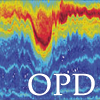
|
Leah Johnson Senior Oceanographer leahjohn@uw.edu Phone 206-221-2616 |
|
Publications |
2000-present and while at APL-UW |
Assessing marine snow dynamics during the demise of the North Atlantic spring bloom using in situ particle imagery Siegel, D.A., and 17 others including L. Johnson, "Assessing marine snow dynamics during the demise of the North Atlantic spring bloom using in situ particle imagery," Global Biogeochem. Cycles, 39, doi:10.1029/2025GB008676, 2025. |
More Info |
1 Nov 2025 |
|||||||
|
The ocean's biological pump, a critical component of the Earth's carbon cycle, transports organic matter from the surface ocean to depth and is dominated by sinking particles, often in the form of marine snow-sized (diameter >= 0.5 mm) aggregates. Controls of sinking particle carbon export are thought to be driven largely using ecological processes that create and transform sinking particles. We diagnose the importance of both biotic and abiotic processes in the dynamics of marine snow and other suspended particles using image-based determination of their size distribution. These observations were made during the demise of the North Atlantic spring bloom in May 2021 as part of the Export Processes in the Ocean from RemoTe Sensing-North Atlantic (EXPORTS-NA) field campaign. We show that intense storm events generated high turbulent mixing rates in the upper ocean that impacted the abundance, size distribution, porosity and sinking of marine snow. Mixed-layer turbulence levels both created and destroyed marine snow and the sequence of entrainment and detrainment of the mixed layer induced by repeated storm forcings enhanced the vertical transport of aggregates to depth. Evidence of biological transformations was also observed at mesopelagic depths, both for the consumption of particulate matter and in the creation of smaller particles from larger ones, likely due to interactions with zooplankton. Collectively, these results illustrate the complex interplay of physical and biological processes regulating the dynamics of marine snow and suggest their inclusion in predictive models of the ocean's biological pump. |
|||||||||
Passive acoustic estimates of sound speed from vertical line array data in the Nordic Seas Taylor, R.T., M.S. Ballard, J.D. Sagers, L. Johnson, and H. Simmons, "Passive acoustic estimates of sound speed from vertical line array data in the Nordic Seas," JASA Express Lett., 5, doi:10.1121/10.0037103, ,2025. |
More Info |
16 Jul 2025 |
|||||||
|
In wind-wave driven ambient sound environments, the cross-correlation of acoustic data recorded on vertically separated hydrophones can provide estimates of the average sound speed between hydrophones. Deployment of a 52-element vertical line array of hydrophones located on a 425 m deep ridge in the Nordic waters near Jan Mayen Island enabled estimates of the water column sound speed profile. Sound speed profiles were estimated for each 24-min recording, which were collected every four hours over the course of the year-long experiment, supplying a wide range of environmental conditions. Over the full experiment, estimated sound speeds had a root-median-square error of 0.79 m/s when compared to direct measurements. |
|||||||||
Spatiotemporal topic modeling reveals storm-driven advection and stirring control plankton community variability in an open ocean eddy San Soucie, J.E., Y. Girdhar, L. Johnson, E.E. Peacock, A. Shalapyonok, and H.M. Sosik, "Spatiotemporal topic modeling reveals storm-driven advection and stirring control plankton community variability in an open ocean eddy," J. Geophys. Res., 129, doi:10.1029/2024JC020907, 2024. |
More Info |
7 Nov 2024 |
|||||||
|
Phytoplankton communities in the open ocean are high-dimensional, sparse, and spatiotemporally heterogeneous. The advent of automated imaging systems has enabled high-resolution observation of these communities, but the amounts of data and their statistical properties make analysis with traditional approaches challenging. Spatiotemporal topic models offer an unsupervised and interpretable approach to dimensionality reduction of sparse, high-dimensional categorical data. Here we use topic modeling to analyze neural-network-classified phytoplankton imagery taken in and around a retentive eddy during the 2021 North Atlantic EXport Processes in the Ocean from Remote Sensing (EXPORTS) field campaign. We investigate the role physical-biological interactions play in altering plankton community composition within the eddy. Analysis of a water mass mixing framework suggests that storm-driven surface advection and stirring were major drivers of the progression of the eddy plankton community away from a diatom bloom over the course of the cruise. |
|||||||||






